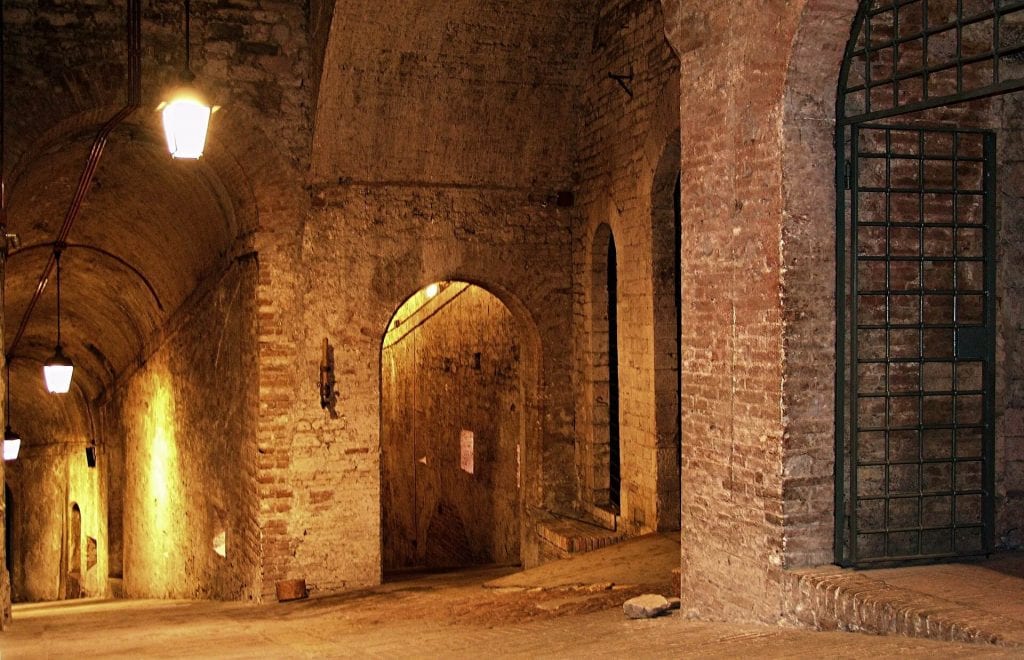Perugia is located about 164 kilometres (102 miles) north of Rome and 148 km (92 miles) southeast of Florence.
Perugia was an Umbrian settlement but first appears in written history as Perusia, one of the 12 confederate cities of Etruria
In the Lombard period Perugia is spoken of as one of the principal cities of Tuscia. In the 9th century, with the consent of Charlemagne and Louis the Pious, it passed under the popes; but by the 11th century its commune was asserting itself, and for many centuries the city continued to maintain an independent life, warring against many of the neighbouring lands and cities— Foligno, Assisi, Spoleto, Todi, Siena, Arezzo.
In 1186 Henry VI, rex romanorum and future emperor, granted diplomatic recognition to the consular government of the city; afterward Pope Innocent III, whose major aim was to give state dignity to the dominions having been constituting the patrimony of St. Peter, acknowledged the validity of the imperial statement and recognised the established civic practices as having the force of law.
Civic peace was constantly disturbed in the 14th century by struggles between the party representing the people (Raspanti) and the nobles (Beccherini). After the assassination in 1398 of Biordo Michelotti, who had made himself lord of Perugia, the city became a pawn in the Italian Wars, passing to Gian Galeazzo Visconti (1400), to Pope Boniface IX (1403), and to Ladislaus of Naples (1408–14) before it settled into a period of sound governance under the Signoria of the condottiero Braccio da Montone (1416–24), who reached a concordance with the Papacy.
Following mutual atrocities of the Oddi and the Baglioni families, power was at last concentrated in the Baglioni, who, though they had no legal position, defied all other authority, though their bloody internal squabbles culminated in a massacre, 14 July 1500. Gian Paolo Baglioni was lured to Rome in 1520 and beheaded by Leo X; and in 1540 Rodolfo, who had slain a papal legate, was defeated by Pier Luigi Farnese, and the city, captured and plundered by his soldiery, was deprived of its privileges. A citadel known as the Rocca Paolina, after the name of Pope Paul III, was built, to designs of Antonio da Sangallo the Younger “ad coercendam Perusinorum audaciam.”
In 1797, the city was conquered by French troops. On 4 February 1798, the Tiberina Republic was formed, with Perugia as capital, and the French tricolour as flag. In 1799, the Tiberina Republic merged to the Roman Republic.
In 1832, 1838 and 1854, Perugia was hit by earthquakes. Following the collapse of the Roman republic of 1848–49, when the Rocca was in part demolished, it was seized in May 1849 by the Austrians. In June 1859 the inhabitants rebelled against the temporal authority of the Pope and established a provisional government, but the insurrection was quashed bloodily by Pius IX’s troops. In September 1860 the city was united finally, along with the rest of Umbria, as part of the Kingdom of Italy.
During World War II the city suffered only some damage and was liberated by the British 8th army on 20 June 1944
Perugia today hosts two main universities, the ancient Università degli Studi (University of Perugia) and the Foreigners University (Università per Stranieri). Stranieri serves as an Italian language and culture school for students from all over the world. Other educational institutions are the Perugia Fine Arts Academy “Pietro Vannucci” (founded in 1573), the Perugia Music Conservatory for the study of classical music, and the RAI Public Broadcasting School of Radio-Television Journalism. The city is also host to the Umbra Institute, an accredited university program for American students studying abroad. The Università dei Sapori (University of Tastes), a National centre for Vocational Education and Training in Food, is located in the city as well.
Churches
- Cathedral of S. Lorenzo
- San Pietro: late 16th-century church and abbey.
- San Domenico: Basilica church of the Dominican order, building began in 1394 and finished in 1458. Before 1234, this site housed markets and a horse fair. The exterior design attributed to Giovanni Pisano, while its interior redecorated in Baroque fashion by Carlo Maderno. The massive belfry was partially cut around the mid-16th century. The interior hosts the splendid tomb of Pope Benedict XI and a wooden choir from the Renaissance period.
- Sant’Angelo, also called San Michele Arcangelo: small paleo-Christian church from the 5th–6th centuries. Sixteen antique columns frame circular layout recalling the Roman church of Santo Stefano Rotondo.
Secular buildings

- The Palazzo dei Priori (Town Hall, encompassing the Collegio del Cambio, Collegio della Mercanzia, and Galleria Nazionale), one of Italy’s greatest buildings. The Collegio del Cambio has frescoes by Pietro Perugino, while the Collegio della Mercanzia has a fine later 14th century wooden interior.
- Galleria Nazionale dell’Umbria, the National Gallery of Umbrian art in Middle Ages and Renaissance (it includes works by Duccio, Piero della Francesca, Beato Angelico, Perugino)
- Fontana Maggiore, a medieval fountain designed by Fra Bevignate and sculpted by Nicola and Giovanni Pisano.
- Chapel of San Severo, which retains a fresco painted by Raphael and Perugino.
- the Rocca Paolina, a Renaissance fortress (1540–1543) of which only a bastion today is remaining. The original design was by Antonio and Aristotile da Sangallo, and included the Porta Marzia (3rd century BC), the tower of Gentile Baglioni’s house and a medieval cellar.
- Orto Botanico dell’Università di Perugia, the university’s botanical garden
- Etruscan Arch (also known as Porta Augusta), an Etruscan gate with Roman elements.


